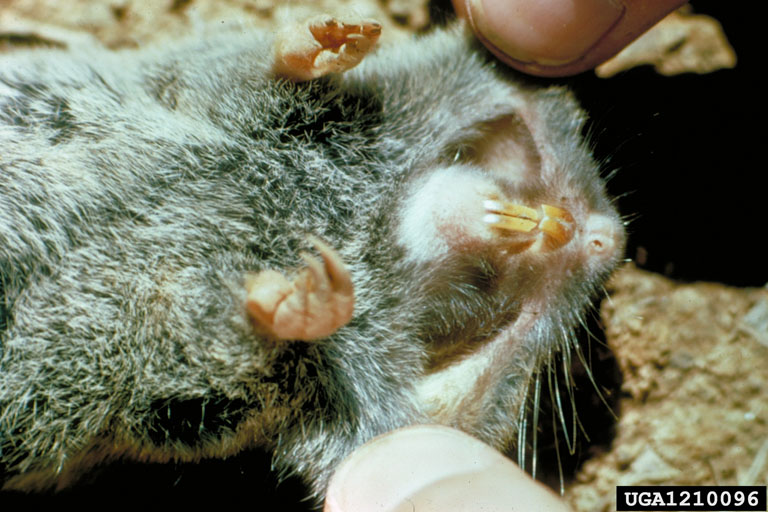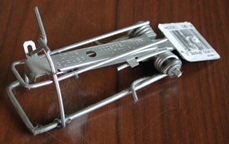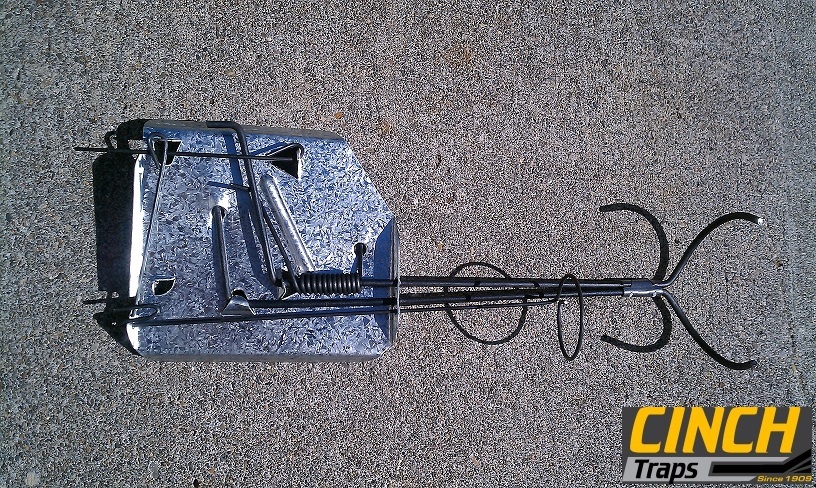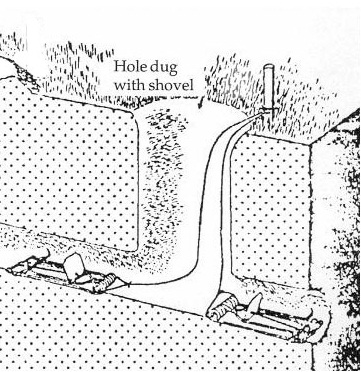 Trapping Pocket Gophers - June 18, 2014 Jeff Schalau, Agent, Agriculture & Natural Resources University of Arizona Cooperative Extension, Yavapai County Pocket gophers can be very destructive when they venture into gardens and landscapes eating root systems and pulling entire plants into their burrows. Their activity always increases during fall and spring. Young are also born in spring and, once they are a few months old, they leave their mother’s burrow system and establish their own territories. To successfully manage pocket gophers in the garden, orchard or landscape, you should learn about their behavior and quickly respond when they are approaching areas where damage could occur. Gopher activity can be recognized by the fan-shaped mounds of loose soil they create when they push soil out of their burrow system. The soil mound will also have a smaller plug of loose soil in the center or to one side of it marking where the burrow has been closed off. Fresh mounds indicate feeding or nesting activity. If the burrow is not plugged, then it could belong to a rock squirrel or be inhabited by another animal. Gopher burrow systems can be very extensive, especially in areas where they have been present for long periods. Pocket gophers are not protected under Arizona Law and may be controlled freely on private property. Trapping is the most effective gopher control strategy for home gardeners. Lethal trapping may seem unsavory to some gardeners, but once you have experienced a few losses, it becomes easier. A minimum of two traps are needed. I use wire body gripping traps and am now experimenting with “Cinch” brand traps. Both types are effective. When using wire body gripping traps, I secure two of them to a metal stake using two foot pieces of baling wire. I also recommend using a steel probe to help in locating burrows. This can be a ¼ inch steel rod bent to create a handle (these double as irrigation probes and Yavapai County Master Gardeners sell them in our two county offices). To set traps, locate the area of the most recent activity (fresh mounds). The mounds will be connected to lateral tunnels that connect to a main tunnel. You can determine which direction the lateral tunnel goes by looking at the fan of loose soil. This is where the gopher pushed the soil above ground. The small plug will be where the burrow begins. However, these lateral tunnels are often backfilled with soil for a foot or so. Using your probe, follow the lateral back to the intersection where the lateral joins the main tunnel. After you think you’ve located the main tunnel, dig a hole to expose both ends. Practice setting the traps to become familiar with them. Once you are comfortable setting the traps, use a spoon or trowel to clean out and expose each opening. Set a trap and carefully insert it all the way into one tunnel entrance while holding the trigger to prevent it from deploying. Do the same in the other tunnel. Cover the exposed tunnels completely so that air drafts are eliminated. Gophers will push soil into the trap if they detect air movement or light. After setting traps, kick over all fresh soil mounds in the area so that any new activity can be easily detected. Check your traps each day and reset them if you are not successful. Do not handle dead gophers with your bare hands. If you catch one gopher per burrow system, you have probably taken care of the problem for that localized area. Gophers are solitary except when they are breeding or nursing young. Continue to trap until you no longer see new mounds then do your best to obliterate existing tunnels to prevent re-colonization from adjacent areas (I use a running hose and stomp the burrows in with my foot). Over time, your trapping success rate should improve as you learn by trial and error. There are other methods of gopher control (toxicants, smoke, flooding, exclusion, etc.). These are recommended for commercial and/or agricultural applications. Repellents and scaring devices are generally ineffective. Below there is an extensive article on pocket gopher management and several images: a gopher mound, pocket gophers, a diagram of a burrow system, traps, and how to set traps as described above. Naming of companies or products is neither meant to imply endorsement by the author nor criticism of similar companies or products not mentioned. Follow the Backyard Gardener on Twitter – use the link on the BYG website. If you have other gardening questions, call the Master Gardener help line in the Camp Verde office at 928-554-8999 Ext. 3 or e-mail us at verdevalleymg@gmail.com and be sure to include your name, address and phone number. Find past Backyard Gardener columns or provide feedback at the Backyard Gardener web site: http://cals.arizona.edu/yavapai/anr/hort/byg/. Additional Resources Pocket Gophers From: The Handbook: Prevention and Control of Wildlife Damage, University of Nebraska - Lincoln digitalcommons.unl.edu/cgi/viewcontent.cgi?article=1013&context=icwdmhandbook  Gopher mound showing direction of burrow and where soil was pushed out of the hole (arrows in a "fan" pattern).  Dead pocket gopher (Thomomys sp.) at Catalina State Park near Tucson, Arizona.  Pocket gopher showing pockets (Thomomys talpoides) (Dave Powell, USDA Forest Service, Bugwood.org).  Wire-type body gripping gopher trap.  "Cinch" (tm) body gripping gopher trap.  Figure 1. Drawing of a pocket gopher burrow system showing top view and side view. The main tunnel has lateral tunnels that terminate with above-ground gopher mounds. Food caches (C) and a nesting chamber (deepest chamber) are also shown.  Figure 4. Diagram showing the main burrow tunnel and where traps should be placed before covering. |